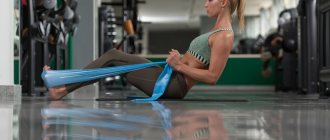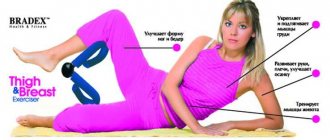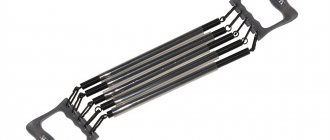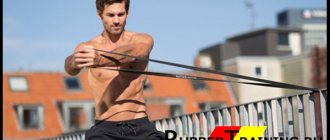Raising your arms behind your back
1.You need to place your feet shoulder-width apart, and raise your arms with the expander in front of you so that your palms are turned inward. Then spread your arms straight to the sides and inhale, then return to the original position and exhale. When you do this exercise, try not to lean back too much and try to look in front of you all the time.
5. We get back to the original position again. But now we must move the expander behind our back so that our arms are bent and our palms face outward. Then straighten your arms to the side and inhale. Then, bend your arms and return to the original position and exhale. Do this exercise with several additional springs.
Nuances of choosing wrist trainers
Even an adjustable expander, which is of good quality and functionality, is not without its drawbacks. It does not have the same reliability as expensive spring ones and may not last very long. After all, it is not at all difficult to break if used incorrectly.
Well, what about other types of wrist expanders? Among them, it is very difficult to find something that could be called a good option for a quality workout. All these balls and elastic bands are more suitable for developing fingers and hands, for example, for rehabilitation after a broken arm. But a soft rubber ring can also do the job.
Although training with a wrist expander is considered a very democratic activity, when purchasing them you should know how not to make a mistake when choosing. One of the most common mistakes is trying exercise machines on a hand that had previously been in a tense state for a long time. You only need to select an expander with a rested hand - this is the only way you can fully experience all the capabilities of the device.
Do not forget to take into account how comfortable the expander lies in your hand - the anatomical features of all people are different. If you already experience pain during the test, it is better to abandon this model and opt for another.
The rigidity of the expander should be such that full compression is difficult for you. Over time, when you are sufficiently trained, you can move on to a tougher version.
General strengthening exercises with an expander
The expander is great for simultaneously working the muscles of the legs and arms. You perform one exercise and work several muscle groups at once. Exercises with an expander are as effective as exercises on large exercise machines, and take much less time.
So, let's look at the main types of general strengthening exercises and training for different muscle groups. Do all exercises 10-15 times in one approach, over time you can increase their number.
- Standing press. Stand on the elastic band of the expander with both feet and take the handles in your hands. Feet should be shoulder width apart. Start performing presses, pulling each arm in turn from hip level to chest level, and if you can, then higher. This way you force your triceps and many leg muscles to work actively.
- Seated press. You can strengthen the muscles of the shoulder girdle using the following exercise: Sit on the floor, stretch your legs, keep your back straight. Place the expander over your feet, grab the handles, and turn your hands with the inside facing up. Take a deep breath while pulling your arms towards your body. As you exhale, lower your arms to the starting position.
- Knee press. Grab the handles of the expander. Place one leg in the middle of the band and bend it at the knee, and take the other back, squatting slightly. One handle can now be released: if the expander is clamped with the right foot, then we hold on to the left handle and lower the right one to the floor. We do presses with one hand first, then change position and perform presses with the other hand. This exercise helps to work the so-called stabilizing muscles. They do not participate in the movement process, but fix and hold a part of the body in the desired position. Remember that weak stabilizer muscles can cause injury even when performing ordinary push-ups, so strengthening them is necessary.
What is an expander for?
The main task of the expander is to create additional weights, with which you can increase the intensity of your workout. Unlike standard exercise equipment and weights, the expander does not take up much extra space, it is easy to use, and does not put any harmful stress on the body.
Ab exercises with an expander may differ from each other, both in the technique of execution and in the purpose of this simulator in each of them. In one case it provides additional resistance, in another, on the contrary, it helps.
The peculiarity of this simulator is that it can be used to work the entire abs, including the oblique muscles. Despite the fact that there are many sets of such exercises, you can always invent something of your own - it is only important to feel what kind of load it gives you and direct it correctly.
Toned abs are not a problem!
- Position. Lying on the floor, legs bent at the knees, feet fixed on the floor surface. One end of the “butterfly” is clamped with the knees, and the other with the hands at face level.
- Exercise. The legs slowly rise, squeezing the expander and putting stress on the abs. It is fixed in this position for several seconds and returns to its original position.
- Intensity. The exercise must be performed 15-20 times per approach.
Useful workouts with an abdominal expander:
- We pump up the press while sitting. This workout is similar to the classic seated ab exercise. We sit on the floor, bend our legs slightly at the knees, everything is as usual, only an expander is clamped under our feet. Grab the handles and pull them towards your chest. Exhale - slowly lower the body back without changing the position of the hands. Inhale - we rise to the starting position.
- We pump up the press while standing. Place your feet shoulder-width apart. Fold the expander in half and insert your left foot into the loop formed. Grasp the resistance band near the ends with your left hand and pull it over your shoulders so that you can grab the handles with your right hand. Bend to the left in this position, while keeping your pelvis motionless.
For triceps
Extension of arms from behind the head
This exercise will help develop all three heads of the triceps with a slight emphasis on the long head. It can be performed with one hand or with both at the same time. In the world of bodybuilding, these EXTENSIONS are DONE WITH A DUMBBELL.
Performance:
- Stand in a separate line. That is, one leg is in front and the other is behind.
- Attach an expander to your back foot.
- Take its edges in your hands and lift them above your head.
- As you inhale, bend your arms at the elbow joints and lower the edges of the expander behind your head.
- Take a short break and stretch your triceps as much as possible.
- As you exhale, straighten your arms and return to the starting position.
The most effective exercises with an expander for men to train various muscle groups
6. Now you should take the expander in your hands and move it behind your back so that the right arm is bent at the shoulder and the left arm is pressed straight to the thigh. Then extend your right arm upward until straight and inhale. Returning to the original position, you need to exhale. Repeat this exercise with both hands.
- Step on the band and place your feet shoulder-width apart.
- Take the loops of the expander in your hands. To make it more comfortable to hold, pass the expander behind your shoulders and hold it in bent arms, as if placing it on your shoulder.
- Do a squat. The back is straight, the pelvis is pulled back, the knees are slightly turned outward.
- Straighten up while stretching the expander.
- Repeat the exercise.
- Hook the resistance band onto a stand close to the floor.
- Insert your ankle into the loop and lie on your stomach.
- Bend your leg at the knee, pulling on the expander.
- Straighten your leg and repeat.
Exercises for legs with an expander are performed as follows: we take one handle of the expander in our hands and put the other on our foot. This is the starting position (can be standing or sitting) from which the following exercises are performed:
- In the starting position, standing, swing your leg to the side. After 10-15 swings, change your supporting leg and perform the exercise on the other side.
- In the same starting position, lift and straighten your leg in front of you, pulling on the expander. While hanging, bend your knee about 5 times. Then turn your leg sideways so that it forms a right angle with your supporting leg. Bend your knee 5 more times. Switch sides and repeat the exercise.
- Position. While standing, one leg should be bent and slightly put forward, arms should be absolutely straight, spread to the sides, and the palms should be facing upward, holding the handles of the expander, the springs of which should be located between the chest and chin.
- Exercise. The arms should be spread as wide as possible, while the knee bends even more and the whole body leans slightly back. In the next approach, you need to change your leg.
- Intensity. This exercise should initially be performed 10 times with an acceptable load. Gradually it is necessary to increase the pace and increase the angle of inclination back.
For biceps
- Position. Standing, the right leg fixes the handle of the expander, legs apart.
- Exercise. The right hand holds the second handle and bends towards the right shoulder. Important: the elbow should not “help”, however, like other muscle groups.
- Intensity. You should start repeating this exercise 10 times and then change your hand. To avoid performing the exercise incorrectly, do not increase the load too sharply.
For chest muscles
- Position. Lying on a bench, the expander passes under the bench, its handles in your hands. The spring is slightly tense, the arms are at chest level, the elbows are spread to the sides.
- Exercise. The arms straighten upward, feeling the tension of the spring. Stay in this position for a few seconds, and the hands return to the starting position.
- Intensity. The exercise must initially be performed 8 to 10 times, gradually increasing the load.
For leg muscles
- Position. Lying on your back, one handle of the expander is fixed in the hand at the level of the pelvis, the second is hooked with the leg bent at the knee.
- Exercise. The leg with the handle is slowly straightened, fixed in this position for several seconds and returned to the starting position. After completing the approach, you should change legs.
- Intensity. You need to start doing the exercise 8-10 times, gradually increasing the pace.

Expanders, depending on their purpose, design features and other parameters, are sold in various variations.
Expanders are distinguished:
- foot and hand;
- children and adults;
- with a certain type of fastening (floor or wall) and universal, etc.
There is another type of expander, which is quite popular among both sexes. It is commonly called a butterfly expander, exercises with which are quite effective for various muscle groups.
For triceps
- Position. While standing, one handle of the expander is on the thigh, the other is resting on the forearm. The elbow is pressed to the body.
- Exercise. The expander is compressed by pressing on the upper handle, then the pressure gradually weakens. After completing the approach, you should change hands.
- Intensity. For the exercise to be effective, it should be performed 10 times per approach with each hand.
- Position. Standing, arms extended upward and holding the butterfly handles.
- Exercise. The “butterfly” must be squeezed as tightly as possible. The more your arms are extended, the more noticeable the result.
- Intensity. This exercise must be performed for 4-5 minutes.
For the back
Bent over expander row
Let's start with basic exercises aimed at developing back thickness. It is an analogue of the BAR ROLL IN THE INCLINE. Depending on the angle of inclination, we can shift the load from the top to the bottom of the latissimus muscles. Due to the fact that we perform rows with both hands, we can take more rigid expanders. This will increase the load on the working muscles. As a result, they will begin to grow.
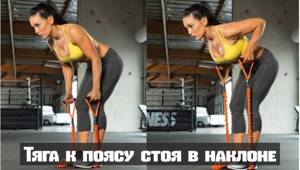
Performance:
- Stand with both feet in the middle of the expander and take its edges in your hands.
- We move the pelvis back and tilt the body forward. For greater stability, bend your knees slightly.
- The back should be straight, there should be a slight arch in the lower back, and the gaze should be directed forward.
- As you exhale, we begin to bring the shoulder blades together and pull the edges of the expander to the lower abdomen (the area under the navel).
- Hold this position for a short time to maximize the load on the latissimus and rhomboid back muscles.
- Then, as you exhale, we return to the starting position.
Exercises for the buttocks: striving for elasticity
Constant exercise is very important for the buttocks to maintain the elasticity of the skin and keep the rather lazy gluteal muscles in good shape.
- You will need to use a chair for this activity. Starting position: standing. Tie your legs with an expander tape and, holding onto a chair, take each leg back in turn as far as possible. You can alternate swings back and sideways. Do them carefully and slowly to get the muscles working.
- While lying down, wrap the tape around your legs, then lift each one in turn.
- Lying on the floor, place the expander over your feet, with your toes pointing toward the ceiling and your legs bent at the knees. Raise each leg in turn, without straightening it, so that your shin is parallel to the floor.
Benefits and possible harm
A hand expander can strengthen your hands, your handshake, and your grip strength. This small exercise machine can improve blood circulation and, accordingly, the general condition of a person. Systematic exercises increase performance. Like any other sport, it has a positive effect on the immune system. For bodybuilders, it is the only opportunity to develop the muscles of the forearms and hands, because other exercises do not work with this group.
You can find a lot of information about harm, but all this is not supported by practice. As during the period of invention, and now, it is considered one of the best exercise machines for arms and forearms, according to doctors and athletes. The only danger that only cheap hand expanders can pose is that a low-quality spring can break and damage the hand. Too hard rubber ones rub the skin, but over time this problem may disappear.

We figured out the training, but what exactly is the benefit of such exercises? As mentioned earlier, training with an expander helps develop the hands and forearms. How many exercises in bodybuilding give such development? Almost none. Therefore, this is the first plus: you develop lagging muscle groups and hands if you use a wrist expander.
The effect begins to appear after just a week of training. This will, first of all, increase the strength of your handshake, as well as your overall grip strength. After such training, it will be easier for you to hold something with your fingers. Also, regular training with a wrist expander is very useful for arm wrestlers, bodybuilders and powerlifters, as well as those who train on apparatus. So such exercises will be beneficial wherever the strength of the forearms, hands, and fingers is required.
But still, wrist expanders also have negative aspects. Cheap spring options can break at any time. Working with a rubber ring, if it is hard, is quite painful, because the friction force of the rubber on the skin is large, and more than one compression must be done. However, gradually the skin can get used to such stress.
This compact device is used to strengthen the muscles of the wrist, fingers and forearm, helping to strengthen the hand grip and improve blood circulation in the upper extremities. If you train often and intensively enough, this will definitely affect the general condition of the body. So the hand expander also provides a general therapeutic effect, strengthening the immune system, that is, the ability to resist various infections. If we talk only about arm wrestlers, bodybuilders and bodybuilders, then for them there is no alternative to using wrist expanders.
The hand expander is one of the few machines with a virtually zero injury rate.
If you are interested in the opinion of doctors about how a hand expander is useful, then it will most likely coincide with the above factors. Plus the opportunity to develop hand muscles after injuries, with arm fractures. This mini-exercise machine will definitely not cause any harm to your health, except for minor inconveniences typical of cheap and too hard rubber models.
The best offers for today. Don't miss out!
Create beautiful hips
Exercises for the hips are simply necessary to create and maintain a beautiful shape for them.
- We tie an expander around our ankles and lie on our back. We raise straight legs perpendicular to the body, turn our feet to the ceiling, straight arms lie along the body with palms down. In this position, we spread our legs to the sides.
- In the same starting position, we move one leg to the side, and keep the other motionless in the same place. Do this several times and switch sides. This exercise perfectly strengthens the inner thigh, which can be worked out with regular training.
- In a lying position, pull the expander band over your toes, while bending your knees. Straighten your legs at an angle of 45 degrees, keeping your pelvis motionless.
In conclusion, it is worth noting that the expander is a universal exercise machine. It can be used by both beginners in sports and professionals.
In addition, the expander is suitable for ladies of any age, build and level of training; it has no contraindications.
The main thing is to do all exercises smoothly and carefully to avoid muscle strains. And once you increase the intensity of your workouts, the expander turns into a cardio exercise machine, which will become a faithful assistant in the fight against excess weight.
For legs
Squats with an expander
When it comes to leg training, the first thing that comes to mind is SQUATS. This is a great exercise to target your quadriceps and glutes.

Performance:
- The beginning is standard for exercises performed while standing.
- We stand in the middle of the expander. We place our legs hip-width apart (slightly narrower than shoulder width).
- We take the edges. We bend our elbows and place them in front of us, so that the expander is behind our forearms.
- The back is straight, there is a natural arch in the lower back. The gaze is directed forward and slightly upward.
- As you inhale, move your pelvis back and bend your knees.
- We take a short pause in the lower position.
- And as you exhale, we rise from the squat.
Watch the position of your knees. In the lower position they should not protrude beyond the toes. While squatting, do not look at your feet. This will make you round up. Start squats with abduction of the pelvis, not bending at the knee.
Become traction on straight legs
Well, where would we be without STANDING ON STRAIGHT LEGS. This exercise helps develop the muscles in the back of the thigh. Which receive virtually no load when doing squats.
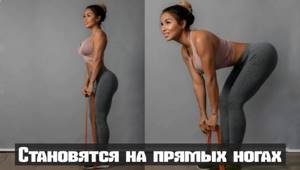
Performance:
- We stand in the middle of the expander and take its ends in our hands.
- As you inhale, we begin to move the pelvis as far back as possible, due to which the forward tilt will occur.
- Stretching the muscles of the back of the thigh as much as possible. Exhale and return to the starting position.
While bending over, do not bend your knees. This will shift the load from the thigh muscles to the gluteal muscles. Do not round your back to avoid damaging your spine.
Lunges with expander
This is a basic exercise that allows you to load the gluteal muscles and quadriceps. LUNCHES can be performed in different ways. Taking a step forward and back. This will load the muscles differently. We will consider the technique of only the classic version.

Performance:
- We stand with one foot in the middle of the expander, and move the other one back.
- We take the edges with our hands and bend them at the elbow.
- While inhaling, bend the leg at the knee joint until an angle of 90° is formed in it.
- After taking a short pause and exhaling, straighten your leg by contracting the quadriceps and gluteal muscles.
While performing the exercise, do not lean forward too much. Make sure that your knee does not extend beyond your toes.
Exercises with an expander for all muscle groups - Video
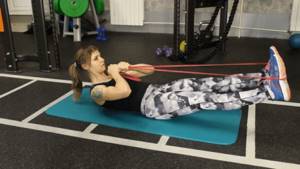
Alternating leg raises
- Lie on the floor, grab the expander in the middle, place your legs in the loops.
- Raise your body so that your lower back remains pressed to the floor.
- Overcoming the resistance of the elastic band, raise your knees one by one.
"Woodcutter"
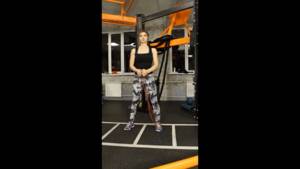
"Woodcutter"
- Place your feet slightly wider than your shoulders, step on one end of the expander with your left foot, and grab the other end with both hands.
- Bend towards the leg under which the expander is located, keeping your back straight.
- As you straighten up, pull the expander diagonally, to the right and up, until your hands are above your right shoulder, above your head.
- Return to the left leg bend and repeat the exercise.
- Repeat on the other side.
- Hook the resistance band around your feet, twist the two ends and grasp the loops or handles in both hands.
- Stand in a prone position - a plank.
- Raise one arm and, stretching the expander, move into a side plank.
- Return to the starting position and repeat on the other side.
Choosing an expander
This simulator has the following varieties:
- Carpal. It should be used for arm training.
- Shoulder – used for training the shoulder joints and neck.
- Chest – used to perform exercises on the chest and back.
- Foot – designed for training legs and hips.
- Incline – used for training joints, twisting and bending.
In addition, when choosing this simulator, you should understand what level of preparedness you have. For example, for beginners, devices with minimal resistance (usually yellow in color) are best suited.
Green exercise machines are suitable for intermediate levels, and blue ones for professional athletes.
Types of spring expanders
This is a simple piece of equipment consisting of two handles connected by springs. It is most often used to expand the chest, however, it can be used for leg and back exercises.
Exercise No. 1
Grasp one handle of the spring expander with your hands, and hold the second handle with your feet. Next, lie on your back, bend your legs at the knee and raise your hips 90˚. Next, as you exhale, straighten your knees, raising your heels to the ceiling, and at the same time pull your hands with the shock absorber handle to your neck.
Do 10 – 15 repetitions, 2 sets in total.
Exercises No. 2
Sit on the floor, bend your knees slightly, hold one handle of the shock absorber with your hands, the other with your feet. As you exhale, lower your body to the ground, straighten your knees, and keep your hands motionless. Then return to the starting position.
Do this for 10–15 repetitions, 2 approaches in total.
Exercise #3
Stand straight, place your feet shoulder-width apart, place the expander behind your back and hold it with your arms bent at the elbows. Then spread your arms to the sides, straightening them completely, and then return them to the starting position.
Perform 2 sets of 8 – 10 times.
Exercise #4
Stand straight, place your feet shoulder-width apart, and hold both handles of the spring shock absorber in your hands. As you exhale, spread your arms, pulling the handles in opposite directions, and while inhaling, slowly return them back.
Do this 15 times and 3 sets.
Exercise #5
Stand with your right foot on the handle of the expander, and grab the second handle with your right hand. Take a step to the side with your left foot. Then, as you exhale, slowly bend to the left, as deeply as possible, and as you inhale, return to the starting position. To increase the load, you can bend your right arm slightly at the elbow.
Thus, perform 10 tilts in one direction. And then the same amount to the other. Only 3 approaches.
This type of simulator has many varieties.
Carpal expander
Perfect for grip training. Among hand exercisers, the most popular and effective are the “Captain Crash” resistance bands and adjustable resistance bands.
Also included in the class of wrist exercisers is the “cocoon” expander, which in fact is ineffective.
There are also devices that allow you to train each finger separately. But they create little effort and are more likely to be used for fun than for training.
You can watch the video on how to use wrist expanders. Here you will learn about prices for exercise equipment.
This simulator was popular back in Soviet times. You can use it to train your upper body. It is convenient due to its simple design and easy load adjustment. By the way, the load is selected by removing or putting on the springs.
Wall spring expanders were the most multifunctional type of spring-type exercise equipment. They have been used since the times of the USSR, but have since undergone some changes - rubber bands have replaced springs.
The simulator is convenient because it can be attached to a wall bars or directly to the wall. Sometimes expanders are part of the DSK (children's sports complex). Such machines allow you to train almost all muscle groups.
A stick with a spring (or butterfly) exercise machine is another representative of spring expanders. Despite the simplicity of the design, you can use it to pump up your chest and arms.
The simulator has only one drawback - it is inconvenient to train your legs with it.
Now about the pleasant things, about the advantages. The main advantage of expanders is that you can train with them at home. And thanks to its compact design, you can take it with you anywhere, be it a business trip or a vacation.
A standard shoulder expander consists of two handles connected by five springs.
The springs are removable, thereby allowing us to adjust the load. This is a definite plus. The springs can be extended by attaching a set of five more springs to them, which will expand the capabilities of the simulator.
Spring hand expanders are the best option for grip training, leaving rubber competitors far behind. Some models of such simulators are universal, for example, Hammar Vice Gripper. The load is adjusted by replacing the springs.
Having familiarized yourself with all types of spring expanders, you can proceed directly to training.




